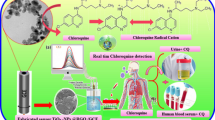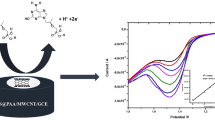Abstract
In this paper, we compare reduced graphene oxide (RGO) electrode with multi-walled carbon nanotubes (MWCNT) as modifiers for the sensitive detection of levofloxacin. The RGO-based sensor showed higher currents for levofloxacin compared with the MWCNT-modified (4-fold) and unmodified electrodes (20-fold). A thin-layer adsorptive process was verified for the oxidation of levofloxacin on the RGO-modified electrode which explains the higher currents. Differential pulse voltammetry (DPV), square wave voltammetry (SWV), and amperometric detection using flow-injection analysis (FIA-AMP) were evaluated for levofloxacin determination in urine and pharmaceutical samples. Detection limits of 1.45, 6.70, and 1.90 μmol L−1 and recovery levels of 91, 106, and 103%, respectively were obtained. A relative standard deviation lower than 7.7% indicated proper precision. The FIA-AMP using the RGO-modified electrode presented high analytical frequency (around 100 injections per hour) and thus was selected for the analysis of the samples. Statistically, similar results (95% confidence level) compared with ultra-fast liquid chromatography (UFLC) analysis and recovery level of 96% for the analysis of urine were obtained.






Similar content being viewed by others
References
Locatelli M, Ciavarella MT, Paolino D, Celia C, Fiscarelli E, Ricciotti G, Pompilio A, Di Bonaventura G, Grande R, Zengin G, Di Marzio L (2015) Determination of ciprofloxacin and levofloxacin in human sputum collected from cystic fibrosis patients using microextraction by packed sorbent-high performance liquid chromatography photodiode array detector. J Chromatogr A 1419:58–66
Maleque M, Hasan MR, Hossen F, Safi S (2012) Development and validation of a simple UV spectrophotometric method for the determination of levofloxacin both in bulk and marketed dosage formulations. J Pharm Anal 2(6):454–457
Wen W, Zhao D-M, Zhang X-H, Xiong H-Y, Wang S-F, Chen W, Zhao Y-D (2012) One-step fabrication of poly(o-aminophenol)/multi-walled carbon nanotubes composite film modified electrode and its application for levofloxacin determination in pharmaceuticals. Sensors Actuat B Chem 174:202–209
Ghanbari MH, Khoshroo A, Sobati H, Ganjali MR, Rahimi-Nasrabadi M, Ahmadi F (2019) An electrochemical sensor based on poly (l-cysteine)@AuNPs @ reduced graphene oxide nanocomposite for determination of levofloxacin. Microchem J 147:198–206
Tang L, Tong Y, Zheng R, Liu W, Gu Y, Li C, Chen R, Zhang Z (2014) Ag nanoparticles and electrospun CeO2-Au composite nanofibers modified glassy carbon electrode for determination of levofloxacin. Sensors Actuat B Chem 203:95–101
Borowiec J, Yan K, Tin C-C, Zhang J (2015) Synthesis of PDDA functionalized reduced Graphene oxide decorated with gold nanoparticles and its electrochemical response toward levofloxacin. J Electrochem Soc 162(3):6
Hidi IJ, Jahn M, Pletz MW, Weber K, Cialla-May D, Popp J (2016) Toward levofloxacin monitoring in human urine samples by employing the LoC-SERS technique. J Phys Chem C 120(37):20613–20623
Wang F, Zhu L, Zhang J (2014) Electrochemical sensor for levofloxacin based on molecularly imprinted polypyrrole–graphene–gold nanoparticles modified electrode. Sensors Actuat B Chem 192:642–647
Wong A, Santos AM, Fatibello-Filho O (2018) Simultaneous determination of paracetamol and levofloxacin using a glassy carbon electrode modified with carbon black, silver nanoparticles and PEDOT:PSS film. Sensors Actuat B Chem 255:2264–2273
Chen T-S, Huang K-L, Chen J-L (2012) An electrochemical approach to simultaneous determination of acetaminophen and ofloxacin. B Environ Contam Tox 89(6):1284–1288
Cesarino V, Cesarino I, Moraes FC, Machado SAS, Mascaro LH (2014) Carbon nanotubes modified with SnO2 rods for levofloxacin detection. J Braz Chem Soc 25:502–508
Moraes FC, Silva TA, Cesarino I, Lanza MRV, Machado SAS (2013) Antibiotic detection in urine using electrochemical sensors based on vertically aligned carbon nanotubes. Electroanal 25(9):2092–2099
Szerkus O, Jacyna J, Gibas A, Sieczkowski M, Siluk D, Matuszewski M, Kaliszan R, Markuszewski MJ (2017) Robust HPLC–MS/MS method for levofloxacin and ciprofloxacin determination in human prostate tissue. J Pharm Biomed Anal 132:173–183
Faria AF, de Souza MVN, de Almeida MV, de Oliveira MAL (2006) Simultaneous separation of five fluoroquinolone antibiotics by capillary zone electrophoresis. Anal Chim Acta 579(2):185–192
Dong Y, Su M, Chen P, Sun H (2015) Chemiluminescence of carbon dots induced by diperiodato-nicklate (IV) in alkaline solution and its application to a quenchometric flow-injection assays of paracetamol, L-cysteine and glutathione. Microchim Acta 182(5):1071–1077
El-Hamshary MS, Fouad MA, Hanafi RS, Al-Easa HS, El-Moghazy SM (2019) Screening and optimization of samarium-assisted complexation for the determination of norfloxacin, levofloxacin and lomefloxacin in their corresponding dosage forms employing spectrofluorimetry. Spectrochim Acta A 206:578–587
Rkik M, Brahim MB, Samet Y (2017) Electrochemical determination of levofloxacin antibiotic in biological samples using boron doped diamond electrode. J Electroanal Chem 794:175–181
Cháfer-Pericás C, Maquieira Á, Puchades R (2010) Fast screening methods to detect antibiotic residues in food samples. TrAC Trends Anal Chem 29(9):1038–1049
Faria LV, Lima AP, Araújo FM, Lisboa TP, Matos MAC, Munoz RAA, Matos RC (2019) High-throughput amperometric determination of tetracycline residues in milk and quality control of pharmaceutical formulations: flow-injection versus batch-injection analysis. Anal Methods 11(41):5328–5336
McCreery RL (2008) Advanced carbon electrode materials for molecular electrochemistry. Chem Rev 108(7):2646–2687
Justino CIL, Gomes AR, Freitas AC, Duarte AC, Rocha-Santos TAP (2017) Graphene based sensors and biosensors. TrAC Trends Anal Chem 91:53–66
Lima AP, Catto AC, Longo E, Nossol E, Richter EM, Munoz RAA (2019) Investigation on acid functionalization of double-walled carbon nanotubes of different lengths on the development of amperometric sensors. Electrochim Acta 299:762–771
Nigović B, Mornar A, Brusač E, Jeličić M-L (2019) Selective sensor for simultaneous determination of mesalazine and folic acid using chitosan coated carbon nanotubes functionalized with amino groups. J Electroanal Chem 851:113450
Sánchez Arribas A, Moreno M, González L, Blázquez N, Bermejo E, Zapardiel A, Chicharro M (2020) A comparative study of carbon nanotube dispersions assisted by cationic reagents as electrode modifiers: preparation, characterization and electrochemical performance for gallic acid detection. J Electroanal Chem 857:113750
Stefano JS, Lima AP, Nascentes CC, Krzyzaniak SR, Mello PA, Gonçalves JM, Richter EM, Nossol E, Munoz RAA (2020) Electrochemical detection of 2,4,6-trinitrotoluene on carbon nanotube modified electrode: effect of acid functionalization. J Solid State Electrochem 24(1):121–129
de Faria LV, Lisboa TP, Azevedo GC, Sousa RA, Costa Matos MA, Muñoz RAA, Camargo Matos R (2019) Chemically-reduced graphene oxide sensor for dipyrone quantification in pharmaceutical samples using amperometric detection. Electroanal 31(4):646–651
Faria LV, Pereira JFS, Azevedo GC, Matos MAC, Munoz RAA, Matos RC (2019) Square-wave voltammetry determination of ciprofloxacin in pharmaceutical formulations and milk using a reduced graphene oxide sensor. J Braz Chem Soc 30:1947–1954
Ziyatdinova G, Gainetdinova A, Morozov M, Budnikov H, Grazhulene S, Red’kin A (2012) Voltammetric detection of synthetic water-soluble phenolic antioxidants using carbon nanotube based electrodes. J Solid State Electrochem 16(1):127–134
Sims MJ, Rees NV, Dickinson EJF, Compton RG (2010) Effects of thin-layer diffusion in the electrochemical detection of nicotine on basal plane pyrolytic graphite (BPPG) electrodes modified with layers of multi-walled carbon nanotubes (MWCNT-BPPG). Sensors Actuat B Chem 144(1):153–158
Rocha DP, Dornellas RM, Cardoso RM, Narciso LCD, Silva MNT, Nossol E, Richter EM, Munoz RAA (2018) Chemically versus electrochemically reduced graphene oxide: improved amperometric and voltammetric sensors of phenolic compounds on higher roughness surfaces. Sensors Actuat B Chem 254:701–708
Li S-J, Xing Y, Deng D-H, Shi M-M, Guan P-P (2015) A comparative study of different types of reduced graphene oxides as electrochemical sensing platforms for hydroquinone and catechol. J Solid State Electrochem 19(3):861–870
Cui F, Zhang X (2013) A method based on electrodeposition of reduced graphene oxide on glassy carbon electrode for sensitive detection of theophylline. J Solid State Electrochem 17(1):167–173
S-j L, Deng D-H, Pang H, Liu L, Xing Y, Liu S-R (2012) Preparation of electrochemically reduced graphene oxide-modified electrode and its application for determination of p-aminophenol. J Solid State Electrochem 16(9):2883–2889
Rodríguez MP, Pezza HR, Pezza L (2016) Simple and clean determination of tetracyclines by flow injection analysis. Spectrochim Acta A 153:386–392
Laube N, Mohr B, Hesse A (2001) Laser-probe-based investigation of the evolution of particle size distributions of calcium oxalate particles formed in artificial urines. J Crys Growth 233(1):367–374
Cardoso RM, Montes RHO, Lima AP, Dornellas RM, Nossol E, Richter EM, Munoz RAA (2015) Multi-walled carbon nanotubes: size-dependent electrochemistry of phenolic compounds. Electrochim Acta 176:36–43
Liu C, Xie D, Liu P, Xie S, Wang S, Cheng F, Zhang M, Wang L (2018) Voltammetric determination of levofloxacin using silver nanoparticles deposited on a thin nickel oxide porous film. Microchim Acta 186(1):21
Oliveira LH, Filho LAP, Santos AL, Takeuchi RM, Trindade MAG (2015) Mathematical processing comparison of voltammetric data: application with the simultaneous determination of fluoroquinolones. Quím Nova 38(10):7
Brazil (2017) Provides for the validation of analytical methods and provides other measures. RDC N°166. National Health Surveillance Agency, Health Ministry, Brasilia. <http://www.in.gov.br/materia//asset_publisher/Kujrw0TZC2Mb/content/id/19194581/do1-2017-07-25-resolucao-rdc-n-166-de-24-julho-de-2017-19194412>. Accessed 22 Feb 2020
Funding
This research was supported by FAPEMIG (Research Support Foundation of the State of Minas Gerais, process: APQ-00197-18), CNPq (National Council for Scientific and Technological Development, process: 307271/2017-0), CAPES (Coordination for the Improvement of Higher Education Personnel, financial code 001), and PROPESQ/UFJF.
Author information
Authors and Affiliations
Corresponding author
Additional information
Publisher’s note
Springer Nature remains neutral with regard to jurisdictional claims in published maps and institutional affiliations.
Rights and permissions
About this article
Cite this article
de Farias, D.M., de Faria, L.V., Lisboa, T.P. et al. Determination of levofloxacin in pharmaceutical formulations and urine at reduced graphene oxide and carbon nanotube-modified electrodes. J Solid State Electrochem 24, 1165–1173 (2020). https://doi.org/10.1007/s10008-020-04589-z
Received:
Revised:
Accepted:
Published:
Issue Date:
DOI: https://doi.org/10.1007/s10008-020-04589-z




